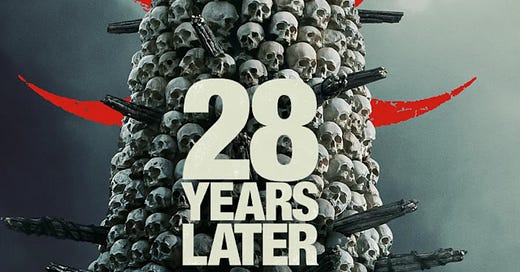The first item to clarify about 28 Years Later, within the universe of its prequel films 28 Days Later (2002) and 28 Weeks Later (2007), is that it is a PART ONE.
As with the first Dune movie in 2021, nobody told me this. Not the marketing, not the signs, not the title.
So I went in expecting a stand-alone, self-contained movie.
When the movie’s prologue never recurred in the first three acts, which involved a young blonde boy escaping into the woods with his Anglican father’s cross necklace, I wondered confusedly what the prologue had to do with anything.
Watched as a standalone movie, 28 Years Later: PART ONE could work, but the ending is too bonkers for a proper unified work.
I’m glad to learn now that two sequels are in the works, to justify my confusion with this film.
What are they doing with this planned trilogy? A hero’s journey with a 13-year-old British boy, who grows up on Holy Island just off the east coast of Britain.
He lives in a self-contained retro-bubble, “retro” for us, a small village ala Shmalayan’s The Village with no electricity and no running water, but plenty of old-world society. They are safe from the zombie apocalypse that’s ravaged the world. A long causeway, only walkable during low tide, connects the island to the mainland.
In the first act, the boy Spike is taken on a hunter’s initiation to the British mainland by his father. They, like Odysseus and Telemachus, are armed with bow and arrow. The father trains young Spike to shoot zombies through the head. Some of them crawl, the obese ones, so Spike starts with those. Others run like Carl Lewis at the human pair.
Eventually Spike and father nearly get captured by an “Alpha,” a Goliath zombie that takes dozens of arrows to stop.
Something’s going on with this movie’s zombies, though it’s only a passing effort instead of a thorough one, as it ought to be. These zombies are given a bit of biological naturalism. While they run around like mad primitives, they probably have a functioning society of some kind.
One of them is — good God almighty! — pregnant.
Back at the village, Spike’s mom has a strange illness. When dad seems to care nothing for mother while shagging a young village lady, Spike takes his mom to the mainland to find Dr. Kelson.
If you’ve seen the trailer — and I’ve seen it three times per NBA playoff game I’ve watched — you’ll spot Ralph Fiennes prominently. He’s Dr. Kelson, but I am sad to report that the trailer’s pulling one over on you. Fiennes is only in the movie’s third act, for about 20 minutes. The meandering middle of 28 Years Later has Spike and mother ambling through the green countryside.
I was wondering where the advanced weapons were in this movie, since the apocalypse occurred in the late 1990s (via the first movie in the franchise, 28 Days Later, also directed by Danny Boyle). Bow and arrow? What happened to guns? Surely someone from the village found a government arsenal.
But this one is penned by writer Alex Garland, who directed the abominable Civil War, which imagined futuristic warfare on the American continent as involving no drones and no cellphones. Recent wars, those in the last week even, have made that choice look rather silly.
He’s more concerned with his story’s Annihilation-style journey into a sci-fi zone. Couple that with director Boyle’s interest in Dickensian tales of British lads growing up, and you get the basic story of Spike in 28 Years Later.
Truthfully, this is one of the more artistically interesting zombie movies you’ll see, at least visually, thanks to Boyle’s flare for angular shots combined with quick-paced editing.
Yet the three acts really don’t cohere much, and the characters seem quite thin. I now know why: I have only seen a third of what Boyle and Garland are offering up.
It’s puzzling that they didn’t bother to tell me that at all.
The movie gestures towards a possible faith-journey for Spike, towards a man with a golden cross. “Have faith,” we are told in the prologue. Faith in what? This movie contains haunting empty churches and piles of skulls, resembling one of its predecessor films, Apocalypse Now.
Spike must realize here that death, in a world altered entirely by death — shades of COVID-19 I’m sure — comes for all sometime. “Memento mori” is what he is told to place in his heart. It’s the most basic of lessons. With paper-thin characters some may not care for, it won’t land.
And anyway, that is a slim hope. But we’ll see what parts 2 and 3 hold in store.
Given the end of this film, one thing is guaranteed: skulls, spines and buckets of blood.





